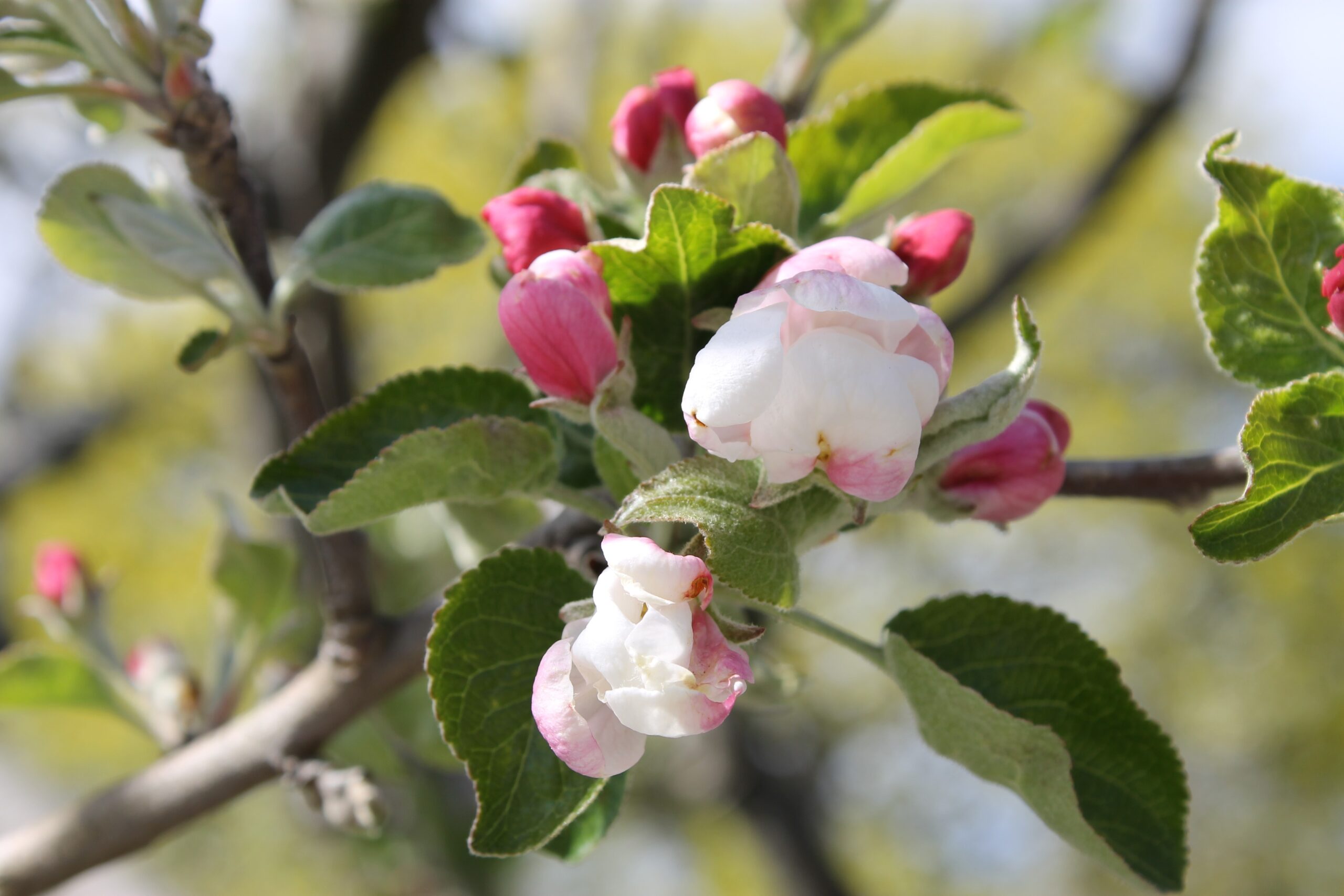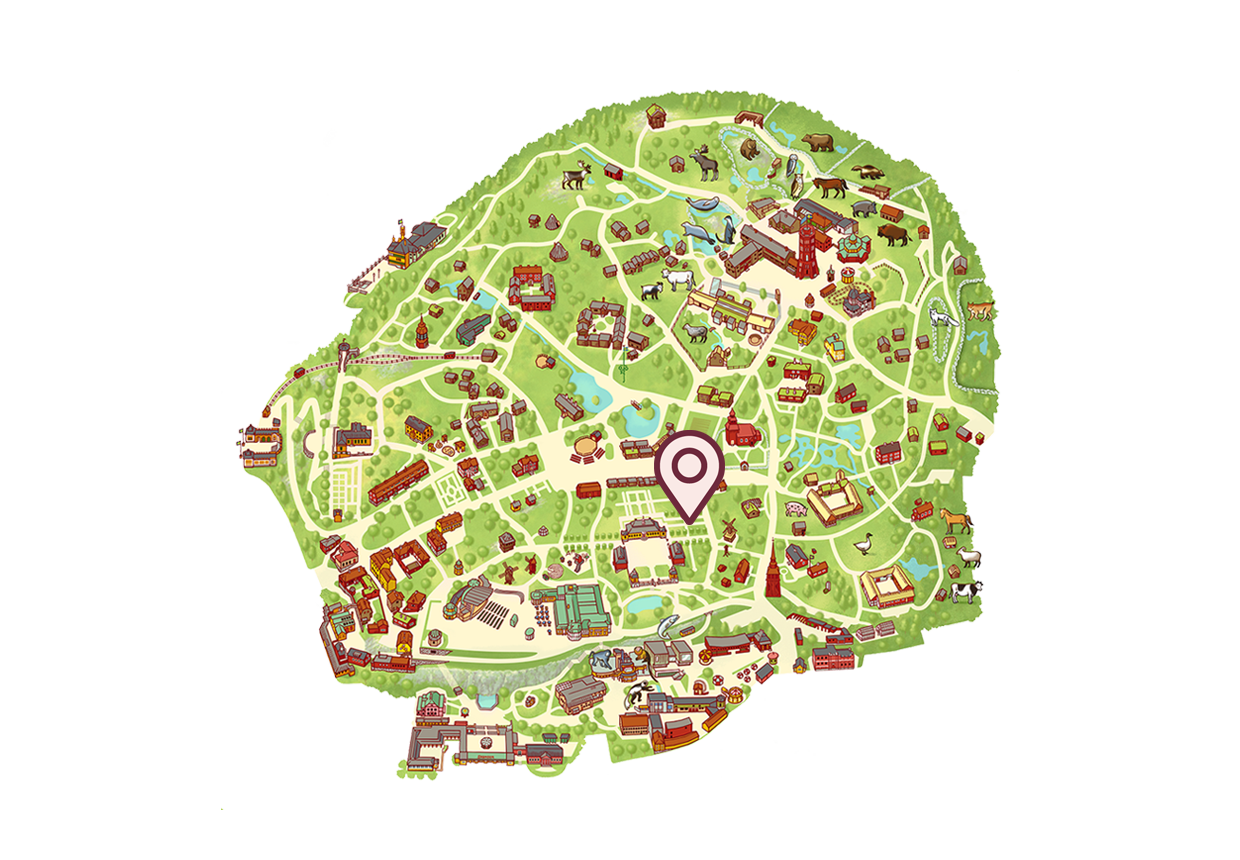- See and do
- Open air museum
- Gardens
- Skogaholm’s apple orchard
Skogaholm’s apple orchard
Step into the shade of the apple trees and admire Skogaholm’s apple orchard. See what’s sprouting in the kitchen garden. There are many different types of apple here, including both common varieties and more unusual ones.
-
Sweden has a long history of growing fruit. The nobility laid out large orchards on their estates during the 17th century, and soldiers brought cultivation skills and new varieties of fruit to Sweden from the wars on the Continent.
Swedish apple cultivation through the ages
1709 proved to be a difficult year for Swedish orchards. The unusually cold, bitter winter destroyed almost all the country’s fruit trees. To replace the lost orchards, many trees were purchased from abroad by manors and estates, but the surviving trees were also nurtured and propagated.
It was only now, in the early 18th century, that it became common to refer to different apple varieties by name. Beautiful names such as Sommar-Calville, Archangelska, Renaittes Jaunes, Pigeons Rouges and Muscoviske all provide clues about the origins of the imported varieties. On larger estates, it was not uncommon to have 40 to 50 different varieties of apple in the orchards. Well into the 20th century, manor houses were the main producers of both fruit and fruit trees for sale and for their own use.
-

Skogaholm’s apple orchard at Skansen
-
During the 19th century, agricultural societies, horticultural schools and gardening associations also contributed towards the knowledge and dissemination of different fruit varieties. Several pomonas were now published – often beautifully illustrated descriptions of different fruit varieties. The most important of these is Olof Enroth’s “Handbook of Swedish Pomology”, which was published in two volumes in 1864 and 1866, and in which he emphasises the great importance of fruit growing in the preface: “A people without nobler fruits, without the need for them, without knowledge of them, is a crude people.”
It has been estimated that there were around 500 different apple varieties in Sweden at the turn of the twentieth century. After the Second World War, however, the number of varieties sold had decreased significantly, and it was hard to find older varieties at regular garden shops.
However, there has been growing interest in old, historic varieties in recent decades, partly thanks to POM – the Programme for Diversity of Cultivated Plants. Many of the old varieties have now been preserved for the future in clone archives and at open-air museums around the country.
-
Apple varieties in Skogaholm’s garden
A number of apple varieties have been preserved in Skogaholm’s garden. Some varieties have several names, with the most common being given first.
Borgherre/Bullerhus
An ancient variety which, according to Olof Eneroth, originates from Saxony. Cultivated in Sweden since the 18th century, and possibly even earlier. Hardy, fast growing and disease-free. The apples ripen in November and can be stored until February. The flavour is tart and the fruit is best suited as a cooking apple.
Danzigsäpple/Kantäpple/Vinterkalvill/Farosäpple
This variety was widespread in both the Netherlands and Germany in the 18th century. Its origin is unknown, but it is probably German. Cultivated in Sweden since the early 19th century. The apples ripen in December and can be stored until February. The flavour is sweet-tart and it has a good aroma.
Frösåker
Named after the Frösåker estate in Västmanland, where pomologist Olof Eneroth found this apple in the mid-19th century. A healthy and easy-to-grow tree. The fruit ripens in October and can be stored until January. The flavour is quite sweet, with a slight tartness and a good aroma.
Gravensteiner
Of uncertain origin, but possibly brought to Graasten Castle in Schleswig, Denmark, from Italy in the late 17th century. A fast growing tree that comes into fruit late and can be severely affected by scab. The apples ripen in November and keep a few months. Excellent flavour and good as a dessert apple.
Kesäter
The name comes from Kesäter’s farm in Sörmland. It was widely grown in Sweden in the 19th century, but increasingly disappeared from cultivation because the apples are relatively small. The tree is hardy and has an abundant yield, but is slow growing. The fruit ripens in January and keeps for two to three months. The flavour is moderately tart with a fairly good aroma.
Mecklenburger King’s Apple
This variety comes from Mecklenburg in Germany, where it has long been cultivated. When exactly it came to Sweden is unknown, but it has been cultivated particularly widely in Blekinge and Urshult in Småland. The tree is hardy, and the fruit ripens in December and keeps for two to three months. The flavour is sweet, a little bland and slightly tart.
Menigasker
This variety comes from an old rootstock tree that grew at a sergeant’s residence in the village of Menigasker in Asker parish, Närke. Some old trees remain in Närke and Sörmland. The variety is hardy, grows quickly and begins to bear fruit early. The fruit ripens in December or January and keeps for a few months. The flesh is juicy, but the flavour is peculiar and makes it unsuitable as an eating apple.
Princess Noble
An ancient variety of unknown origin. Cultivated in Germany in the 18th century, while in Sweden it was most common in Skåne and the Gothenburg region. The tree is hardy and resistant to disease, but grows slowly. The apples ripen in December and can be stored until February or March. The fruit is juicy and sweet, with slight tartness and a hint of cinnamon flavour. Used as an eating apple.
Rossvik
Unknown origin, but the oldest known tree was at Rossvik farm, south of Eskilstuna, where it had grown since the beginning of the 19th century. Most widespread in central Sweden, and propagated as recently as the 1950s by the county nursery in Uppsala. The tree is hardy and fast growing, with a high crown. The fruit ripens in January and keeps until April or May. The flavour is slightly tart, sweet and aromatic.
Red Astrachan
First mentioned in Sweden in 1780, but was probably cultivated much earlier. Despite the name, it is not closely related to the White Astrachan. The apple has been assumed to be of Swedish origin, and the variety was exported to England in 1816 where it was recognised as a very beautiful and delicious apple. It has been fairly widely spread across the country. The tree grows quickly, but is highly susceptible to fungal diseases. The fruit ripens in September and should be eaten immediately.
Red Iron Apple
Unknown origin, but has probably been present in Sweden for a very long time, possibly as early as the 16th century. It has also long been cultivated in Germany, where it has been planted alongside roads because the fruit is quite firmly attached to the trees. The tree is hardy and healthy, and grows well even in poor soil. The fruit ripens in early spring and is edible in spring and summer, and has a sweet but slightly bland flavour.
Sommarkaneläpple
Of unknown origin, and hard to identify as a variety. First described in the late 19th century. The tree is small and very hardy. The fruit ripens in early September and keeps for a few weeks. The apple is very juicy and has a good flavour.
White Astrachan
A very old apple variety that used to be among the most commonly grown in central Sweden. It has been said to be of Russian origin, but this is uncertain. The variety develops best in the northern part of the country. The tree is hardy but slow growing, and can easily be affected by fungal diseases. The fruit ripens in late August or early September, and can be left on the tree to be harvested later. The flesh is loose and juicy, and has good flavour. Quickly becomes floury, but tends to form clear fruits.
Vitgylling/Virginskt Rosenäpple/Sommargylling
Considered to be one of Europe’s oldest apple varieties, and probably came to Sweden via the Netherlands. There are a number of different local variations, such as Mälardalen Vitgylling and Stensnäs Vitgylling. The tree has luxuriant foliage, grows quickly and has a widespread crown. It often bears an abundance of fruit, but can be affected by canker. The fruit ripens in August or September and has a short shelf life. The flavour is slightly tart without any sweetness, and the aroma is weak.
Åker��
The variety’s mother tree still grows at Carl Gustaf Tessin’s Åkerö estate in Södermanland, and may have come to Sweden with a consignment of Dutch fruit trees in 1759. The variety has spread to several countries, and in the early 20th century was one of Sweden’s most cultivated winter fruit trees. There are several different varieties of Åkerö with different degrees of fertility and fruit colour, but all trees grow very quickly. The fruit ripens in November and keeps until February. The flavour is sweet, mild, tart and aromatic.
Ökna Lökäpple
The name comes from Ökna farm in Floda parish, Sörmland, where Olof Eneroth found the apple in the 1860s. The variety can be found in areas of Mälardalen and has similarities to foreign varieties. However, it has not been possible to agree on which variety it might be, so it has kept its Swedish name. The tree grows slowly and has a dense crown. It bears fruit late but abundantly, and is resistant to disease. The apples ripen in December and keep for two to three months. The flavour is slightly sweet, with some tartness and aroma.
Öland King’s Apple
The variety was described by Olof Eneroth in the 1860s. Its origin is unknown, but during the 19th century it was widely grown on the islands of Öland and Gotland, and along the east coast up as far as Stockholm. The variety is said to thrive particularly well in calcareous soil and is favoured for its attractive apples, which were considered particularly suitable as Christmas tree apples. The tree is healthy and hardy as far as north of Lake Mälaren. It grows at a moderate rate and starts bearing fruit late. The fruit ripens in October and lasts until December. The flavour is slightly sweet and tart with good aroma, and the apple is well suited as an eating apple.
Find Skogaholm’s apple orchard
